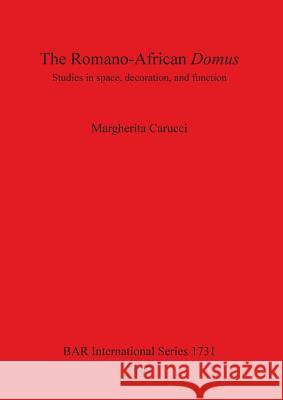The Romano-African Domus: Studies in space, decoration, and function » książka
The Romano-African Domus: Studies in space, decoration, and function
ISBN-13: 9781407301754 / Angielski / Miękka / 2007 / 304 str.
Roman Africa. Until recently, scholars have tended to study architecture and decoration of Roman houses as separate, visual forms of classical art to be analysed in terms of description, classification, and typological survey. This new work follows recent scholarship, in contrast, by examining domestic buildings as a source of information about certain aspects of Roman social realities. Specifically, the author looks at questions such as: How can the function of a room be identified? Can architectural details and floor mosaics tell us something about the activities carried out in domestic spaces? How did they influence the viewer in his thoughts, feelings, and actions? What can type, shape, and design of the floor mosaic say? Is it possible to detect a thematic organisation for the decoration of the whole house? What can we say about the patrons who were paying for the decoration of their houses, about their status, class-aspirations, and achievements? Can spatial organization and decoration detect pattern of social interactions taking place within the house? The final objective of the study is to attempt an understanding of the wealthy class of Romano-African society, its concerns, intentions, and desires. Architecture and mosaic, if analysed as complementary parts of a whole, can offer a wide range of detail on the identity of the inhabitants and society. Form, decoration, and use of domestic space are influenced not only by environmental and economic conditions, but also by the patterns of social interactions taking place within the house.
Roman Africa. Until recently, scholars have tended to study architecture and decoration of Roman houses as separate, visual forms of classical art to be analysed in terms of description, classification, and typological survey. This new work follows recent scholarship, in contrast, by examining domestic buildings as a source of information about certain aspects of Roman social realities. Specifically, the author looks at questions such as: How can the function of a room be identified? Can architectural details and floor mosaics tell us something about the activities carried out in domestic spaces? How did they influence the viewer in his thoughts, feelings, and actions? What can type, shape, and design of the floor mosaic say? Is it possible to detect a thematic organisation for the decoration of the whole house? What can we say about the patrons who were paying for the decoration of their houses, about their status, class-aspirations, and achievements? Can spatial organization and decoration detect pattern of social interactions taking place within the house? The final objective of the study is to attempt an understanding of the wealthy class of Romano-African society, its concerns, intentions, and desires. Architecture and mosaic, if analysed as complementary parts of a whole, can offer a wide range of detail on the identity of the inhabitants and society. Form, decoration, and use of domestic space are influenced not only by environmental and economic conditions, but also by the patterns of social interactions taking place within the house.











